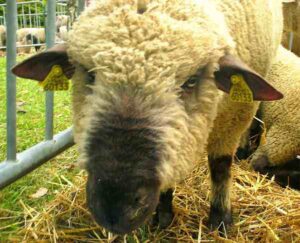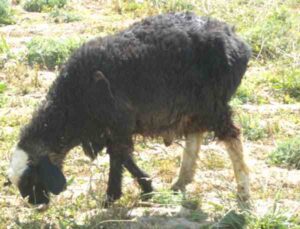The Baluchi sheep is a breed of domestic sheep which was originated from now southern Afghanistan, eastern Iran and southwest Pakistan.
It is a member of the fat-tailed sheep breeds, and it is raised mainly for wool production.
The breed is also known by some other names such as Araghi, Baluchi Dumda, Farahani, Khorasani, Khurasani, Mengali, Neini, Naeini, Mengali, Shinwari, Taraki and Yazdi.
Today the Baluchi sheep is raised and found mainly in it’s native area. And the breed is raised mainly for wool production. Read some more information about this sheep breed below.
Baluchi Sheep Characteristics
The Baluchi sheep are smaller sized animals. They display black and white with black marks on the legs and head. Their face color is generally black.
They are generally polled animals. Average live body weight of the mature Baluchi ewes is around 35 kg. And the mature rams on average weight up to 40 kg. Photo and info from ansi.okstate.edu and Wikipedia.
Uses
The Baluchi sheep is a wool sheep breed. It is raised mainly for wool production.
Special Notes
The Baluchi sheep are strong animals, and they are well adapted to their local climates. They are especially well adapted to the arid, subtropical areas in the eastern Iran, and they are excellent foragers.
Today the breed is raised mainly for wool production. Their wool is coarse with modulation. Average annual fleece weight is between 1.3 and 1.8 kg.
The ewes are pretty good milkers, and they produce enough milk for their lambs. On average an ewe generally produce around 40 to 50 kg of milk in a lactation period of about 125 days. However, review full breed profile of the Baluchi sheep in the following chart.
| Breed Name | Beluchi |
| Other Names | Araghi, Baluchi Dumda, Farahani, Khorasani, Khurasani, Mengali, Neini, Naeini, Mengali, Shinwari, Taraki and Yazdi |
| Breed Purpose | Mainly raised for wool |
| Special Notes | Hardy animals, well adapted to their native climates, excellent foragers, raised mainly for wool production, wool is coarse with modulation, ewes generally produce enough milk for their lambs |
| Breed Size | Small |
| Weight | Mature ram’s average body weight is up to 40 kg, and the mature ewe’s average live body weight is around 35 kg. |
| Horns | Generally polled |
| Climate Tolerance | Native climates |
| Color | Black and white |
| Rarity | Common |
| Country/Place of Origin | Afghanistan, Iran and Pakistan |






